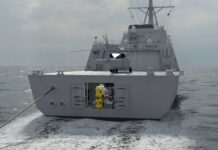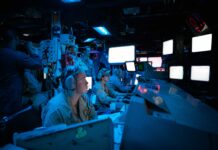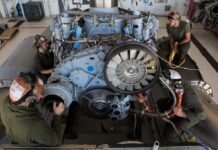The US Naval Air Warfare Center Aircraft Division has awarded Collins Elbit Vision Systems (CEVS) – a joint venture between RTX business Collins Aerospace and Elbit Systems of America – a contract for development, engineering, logistics and test support of the Improved Joint Helmet Mounted Cueing System used in the US Navy’s F/A-18E/F Super Hornet Block III and E/A-18G Growler aircraft.
The contract, worth USD 16 M (EUR M), will cover the delivery of an initial six helmet-mounted displays (HMDs), 21 mass models, six spare visors, three cockpit units, two aircraft kits and associated support equipment for trials.
In addressing the award CEVS has formally launched the Zero-G Helmet Mounted Display System+ (HMDS+), which John Rogers, a former US Air Force F-15C and F-22 pilot who is now the associate director of requirements and capabilities for sixth-generation fighter avionics at Collins Aerospace, described as a “game changer”.
Talking to journalists during an online briefing on 5 September 2023, Rogers said Zero-G “represents a generational shift for helmet-mounted display systems by leveraging the latest display, night vision sensor and processing technologies”.
While Rogers declined to divulge the actual weight of the Zero-G HMD, he noted that it is “a significant percentage lighter” than current-generation HMDs, describing it as “a massive shift in weight and CG [centre of gravity]” in terms of HMD development.
Further detailing the system, Rogers said, “Zero-G uses a binocular waveguide to enable a high-definition colour display with an ultra- wide field of view. The binocular waveguide offers the lightest and smallest form factor available on the market today and requires little to no adjustment, enabling a much quicker, fitting process and the ability to accommodate a larger range of pilots than other HMD systems.

“The ultra-wide-angle display,” he added, “provides the capability to present a high-definition and undistorted image across the entire field of view to enable high and augmented reality, virtual reality, and extended reality training.”
The expectation from CEVS is that, following the US Navy development award, it will be able to bid in open competition to provide HMDs for the US Navy’s entire F/A-18E/F and E/A-18G fleets.
Meanwhile, Rogers noted, “While Zero-G was designed to enable the demanding future mission sets of sixth-gen fighter aircraft, such as the US Air Force NGAD [Next Generation Air Dominance initiative], the US Navy F/A-XX and, of course, FCAS (the Franco-German-Spanish or Future Combat Air System/Système de combat aérien du futur (SCAF)], it can easily be adapted to a wide variety of other tactical platforms such as Eurofighter. This adaptable and scalable approach gives a wide variety of current and future platforms immediate access to advanced battle management technology that will enhance the lethality, effectiveness and survivability of pilots and their platforms.”
Rogers said CEVS is already part of several working groups in Europe in relation to platforms such as Eurofighter and FCAS/SCAF. Asked by ESD about the rival UK/Italian/Japanese Global Combat Air Programme (GCAP) sixth-generation fighter programme, Rogers replied, “We’d love to talk to them as well.”
Explaining the rationale behind the development of the Zero-G HMD, Rogers observed that the “complexity of aerial warfare has evolved remarkably in the last decade and will continue to rapidly change in the years to follow.
“The longstanding motto ‘speed is life’, used to describe the requirement for victory in aerial battles in times past, may not alone guarantee victories in battles of the future,” he said. “As our adversaries of invested heavily in advanced aircraft, high-performance munitions and electronic warfare technologies, future battles present a new level of capability gaps, fog and friction to our warfighters.”
Emphasising that Collins Aerospace and Elbit Systems had partnered for more than 30 years and delivered over 20,000 HMDs to 40 different fighter platforms, Rogers said that CEVS’ investment in the Zero-G HMD “is intended to deliver a product that will enable a generational shift for pilot information management capabilities”.
Peter Felstead













